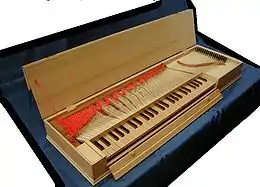Bebung
Bebung (German: a trembling; [ˈbeːbʊŋ]) is a type of vibrato executed on the clavichord.


When a clavichord key is pressed, a small metal tangent strikes a string and remains in contact with it for as long as the key is held down. By applying a rocking pressure up and down the key with the finger, a performer can slightly alter the vibrating length of the string itself, producing the vibrato quality known as bebung. While the vibrato on fretless string instruments such as the violin typically oscillates in pitch both above and below the nominal note, clavichord bebung can only produce pitches above the note.
Sheet music does not often explicitly indicate Bebung. Composers assumed that, like other ornaments, performers would apply bebung at their discretion. Where sheet music does indicate bebung, it appears as a series of dots above or below a note, with the number of dots indicating the number of finger movements. For example:
References
- Brauchli, Bernard (1998). The Clavichord. Cambridge University Press. pp. 267–74. ISBN 0-521-63067-3.
- Grove, George (ed.), A Dictionary of Music and Musicians, vol. i, p.160b